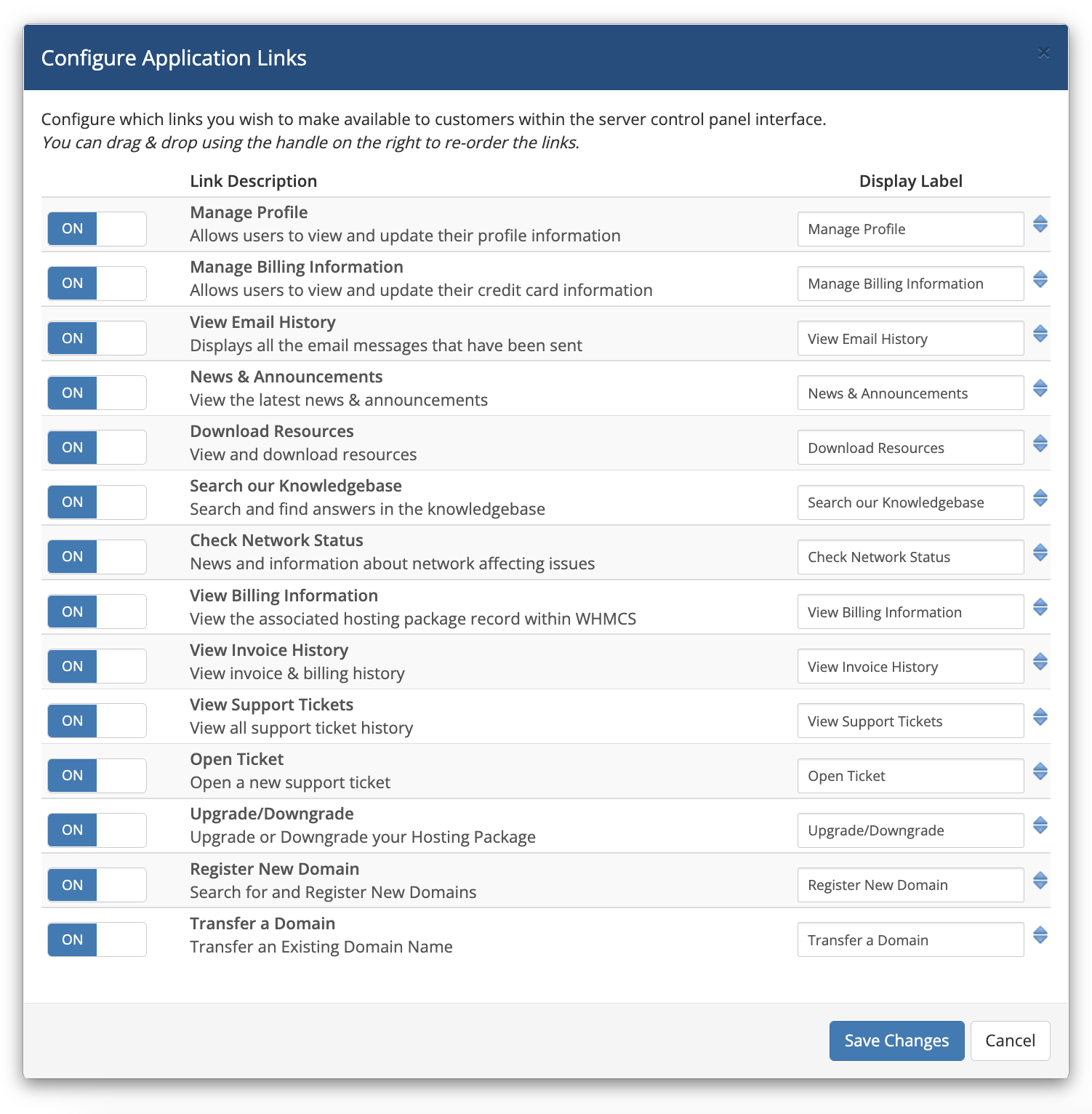Application Links
Contents
Application Linking is the simple way for end users and module developers to integrate with and use WHMCS Single Sign-On.
WHMCS Single Sign-On allows trusted applications to authenticate users and send them to a desired page within the client area.
Supported link destinations include the following:
Ordering
- Upgrade/Downgrade
- Register New Domain
- Transfer a Domain
Support
- Open Ticket
- View Ticket History
- News & Announcements
- Download Resources
- Search our Knowledgebase
- Check Network Status
Account
- Manage Profile
- View Billing Information
- Manage Billing Information
- View Email History
- View Invoice History
You are able to configure which of the above links your end users see and the display label text for each.
Managing Application Links
You can view and manage all modules that support application linking by navigating to Setup > Application Links.
From here you can view modules that support application linking, turn application linking on or off, view the application linking provisioning log and customise the links to provision.
Enabling Application Links
To enable Application Links:
- Navigate to Setup > Application Links. The system will display all of the installed modules that support Application Links.
- Set the toggle to On next to the Application that you wish to enable it for.The option to enable Application Links will be unavailable if you have not configured at least one active server and assigned it to the given module.The status indicator will update to reflect that the system has started provisioning links. When the process finishes, the status indicator will update to show that Application Links are Active for the application.
Configuring Application Links
You can customize the provisioned Application Links on a per-Application basis, allowing you to choose exactly which links your end users receive and what display label they use.
You can configure this before or while you enable application links. The system syncs any changes and pushes them out across all your servers.
To configure application links:
- Navigate to Setup > Application Links.
- Click the Configure link for the Application you wish to make changes for. A modal will load, showing all supported Application Links by that module (see screenshot above). From here you can:
- Slide the toggle setting on or off to enable or disable a given link.
- Customise the display label for a link.
- Drag and drop to reorder the display of links within the Third Party Application.
- Click Save Changes If you have enabled Application Links for the given application, the status indicator will update to reflect that the syncing of your configuration changes has begun. When the process finishes, the status indicator will update to show that Application Links are Active for the application.
Disabling Application Links
To disable application links:
- Navigate to Setup > Application Links.
- Set the toggle to Off for the Application that you wish to disable. The status indicator will update to reflect that the deprovisioning has begun. When the process finishes, the status indicator will update to show that Application Links are Disabled for the application.
Reviewing the Application Link Log
Application links provisioning has its own dedicated logging system. You will see a View Log button for each Application that supports Application Linking.
The log will display log entries for the last provisioning operation that you performed for a given application. These can be an Activation, a sync of Configuration Changes, or a deactivation.
The log uses four logging levels:
- Debug — Event-based logging such as the start and completion of processes.
- Information — You'll see an information level log entry when the system is attempting to provision links to a server that does not support Application Linking. Typically, this means it requires a newer version of the Third Party Application.
- Notice — You'll see a notice level log entry when no servers for the given Application support Application Linking. Typically, this means it requires a newer version of the Third Party Application.
- Warning — Error messages that the Application or module itself returned. These typically require attention.

